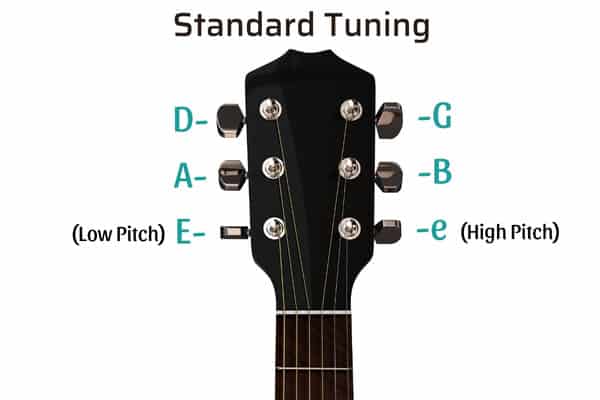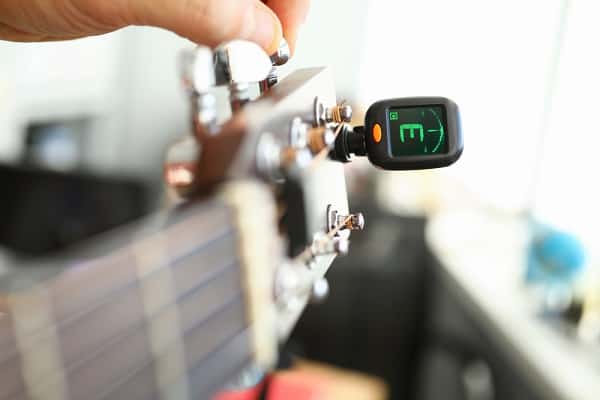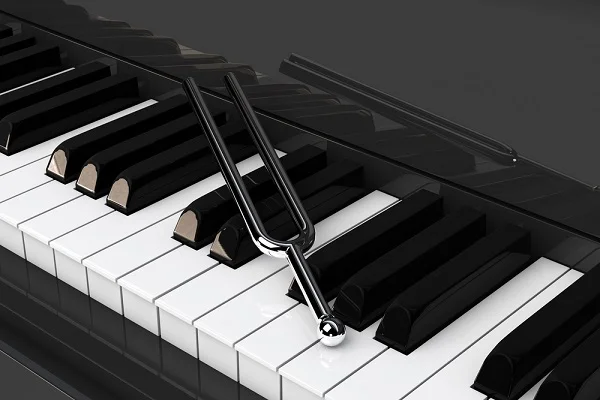When beginning to play guitar, one of the first things you’ll need to learn is how to tune your new instrument. All the practice in the world will avail you little if you’re playing out of tune.
Tuning a guitar may seem daunting the first time you try, but it’s actually a relatively simple and fast process. No matter how well you master producing music on a guitar if your precious instrument is out of tune then you will never be fully satisfied with the results.
There are a few ways in which you can tune your guitar and this article will discuss everything you need to know about tuning your guitar.
Different Types Of Guitar Tuning
Acoustic or Electric guitars can be tuned in many ways for different sounds and purposes. Generally speaking, most guitarists play in what’s known as “standard” tuning.
Standard Tuning
The standard tuning is based on the note “A” vibrating at a frequency of 440 Hertz. You will notice that the six strings on your guitar go from thick to thin. Each of these strings has what we call “notes” and from the thickest to the thinnest, guitar strings should be tuned to E, A, D, G, B, and E.
You can make some sentences using the letters above to remember the order for example:
Eggs Are Dirty Get Bananas Everyday
Once you have memorized the order you need to now learn how to tune your guitar to the notes E-A-D-G-B-E. The guitar’s headstock which extends right after the neck/fretboard has machine heads/tuning pegs that look like keys. You will notice six machine heads-one for each string.

As you turn a machine head you will be changing the pitch of that particularly attached string. Turning the heads will allow you to tune each string to note and with the help of a tuner you can easily find out what note you are working with.
Take a ride to your nearest guitar store and pick up any ax. Odds are, it will be tuned (if it’s in tune at all) to standard.
Many popular guitar tracks are recorded in standard, though many are tuned one-half tone down from standard. Usually, this is done to accommodate a vocalist. Guns-N-Roses, Poison, and Van Halen have all recorded hit songs with guitars tuned down one-half step. To tune down a half-step, tune your guitar’s strings to D#, G#, C#, F#, A#, and D#.
Drop D Tuning
Especially popular among grunge and metal guitarists, “drop d” tuning is simply a variation of the standard and one of the common alternate tunings.
Instead of E, A, D, G, B, and E, tune the thick low-E string down one whole step to D. Now you have D, A, D, G, B, and E. Drop D tuning allows for some easy one-finger power chords that have a lot of “chunk.”
Other Tunings
There are several other guitar tunings, including open G, open B, and open C, a favorite of Kieth Richards. Before you try playing open tunings, though, I’d recommend mastering the standard tuning.
Why You Should Tune To Standard?
Standard tuning isn’t called standard by accident. Most guitar parts are written in standard, and those that are recorded tuned down one-half step can still be played in standard, though they’ll sound slightly different.
Another reason to master standard tuning is that several other tunings are variations on standard. To know standard tuning is to know the first, most important step, so to speak.
Most Common Tuning Techniques
Let us now take a look at some of the most common techniques for tuning an acoustic guitar. We will discuss the following methods to tune a guitar:
a) Tuning using an electronic tuner,
b) Tuning using the strings,
c) Tuning using an app,
d) Tuning using harmonics, and
e) Tuning using other instruments.
Tune an Acoustic Guitar Using A Tuner
There are several different kinds of electric tuners but they all work more or less the same and give you the fastest and most accurate readings.
The good thing about electric tuners is that they don’t only tell you which string you are trying to tune but will also display how far off you are in terms of either going too flat or too sharp.

Follow these easy steps to start the process:
1. Power on the tuner
2. Depending on the tuner you may need to manually set the tuner to ‘listen’ to the string you are tuning or you could set it to auto-detect.
3. Pluck the string and see where the needle (vertical line) is positioned.
4. If it is placed in the middle then the string is already tuned to the right note but if it is not then you need to turn the machine head of that particular string.
5. Turn the machine head in a certain direction to see which way it goes. You need to figure out the right direction to get the needle to come to the middle.
6. You need to pluck the string often to allow the machine to listen and work on it.
7. Once the needle is in the middle then move on to your next string and repeat steps 2-6 until all the strings are perfectly tuned.
This is how an electric tuner works:
For example, if you are tuning the 4th string which is D then you will see 4D on the screen of your electric tuner.
Next, there will be three lights- a red light on the left, a green light on the middle, and another red light on the right.
A vertical line on the screen should be in the middle corresponding with the green light indicating that the note is in tune.
If the line, however, is more to the left and the red light on the left is lit then you should understand that the note is flat.
Again if the line is more to the right side with the red light on the right lit that indicates that the note is too high.
You can also check this video to understand how to tune a guitar with a tuner:
Tune Your Guitar Using its Own Strings
If you don’t have a tuner app installed on your phone or you forgot your electric tuner at home then you need to know how to tune an acoustic guitar without a tuner or by your ear. And in that case, you can try to tune your instrument by following these steps:
1. Start with first tuning the thickest string which is the 6th string.
If you know what the thickest string sounds like then try and tune it closest to a low E. This is important because you will use this as a guideline to tune the remaining 5 strings.
2. Next, you will be working on the 5th string and for that, you must place your finger on the fifth fret of the 6th string.
Once you pluck this string you should be able to hear an A note, the sound you will be aiming for on the 5th string.
Tune the 5th string and while still having your finger on the fifth fret pick both the 6th and the 5th string. Keep turning the 5th strings machine head until both strings sound the same.
3. Moving on to the 4th string you will be following the same method but with a higher string.
In order to get a D note, you must place your first finger on the fifth fret of the 5th string and pluck. The sound you get is what you need from the 4th string.
Turn the machine head of the 4th string and pluck in turn with the 5th string to get both the strings to sound the same.
4. Repeat the same process with the 3rd string but this time starting with your finger on the 5th fret of the 4th string and using it as a guide.
5. A slight change takes place here where in order to tune the 2nd string you must place your finger on the 4th fret of the 3rd string instead of the 5th fret. The rest of the process is the same.
6. To tune the 1st string you go back to the 5th fret of the 2nd string and work from there.
This is an easy way to tune your guitar using the strings and your listening power only. Just remember that while tuning the second string you use the 4th fret of the 3rd string whereas for all the other strings use the 5th fret of the previous string.
Here’s another video to clarify the process of how to tune a guitar without a tuner:
Tune An Acoustic Guitar Using A Tuning App
Got a smartphone? Great.
Many guitarists turn to smartphone apps that help to accurately tune a guitar without costing you anything. Most of these apps are free so as a beginner you don’t have to worry about extra expenses.
Once you have one of these apps installed on your phone all you have to do is follow the instructions that come on the app to successfully complete the tuning process.
But of course, if you want to really get the feel of tuning your guitar you can also consider using an electronic tuner which we will discuss next.
Tune A Guitar Using Harmonics
Playing a harmonic on guitar is a technique that isolates the overtones of a note. The sound produced is high in pitch. Several techniques are used to produce harmonics; to tune your guitar, all you’ll need to master is the most simple.
To tune using harmonics, let your finger rest gently against the low E string right on the fifth fret marker. Sound the string, and you’ll hear a harmonic A. It may take a little experimentation at first to find the right amount of pressure–very little!- needed to sound a harmonic, so don’t be discouraged.
Next, sound a harmonic on the seventh fret of the A string. The tone produced should sound identical in pitch to the harmonic you just sounded on the E string at the fifth fret. If it doesn’t, the strings aren’t in tune, and you need to adjust accordingly.
Continue this process until you come to the B string. Here, you can sound a note normally on the fourth fret of the G string, which should correspond to the natural open B.
Tune A Guitar Using Other Instruments
The problem with using the harmonic method to tune is that you are essentially tuning your guitar to itself. That’s fine if you want to play around, but to be in true standard, you’ll need at least one of your strings to be in tune, and you need to know which it is.

Sounding a corresponding note on another instrument is one way to be sure you’re in tune. Simply sound an A on a recently tuned piano, for example, then tune your second thickest string to that, and you’re off and tuning.
When tuning from another instrument, you can either sound each corresponding note as you tune each string, use the harmonic method, or use the fifth-fret method.
To use the fifth fret method, play the fifth fret on the low E, sounding an A. Tune your A string accordingly, then finger the fifth fret on the A and continue on until you reach the B string. Here, the fourth fret on the G string will correspond; return to the fifth fret on the B.
Frequently Asked Questions
Is It Hard To Tune An Acoustic Guitar?
Acoustic guitar tuning isn’t difficult, though it will likely take a bit of practice at first. It shouldn’t take more than about five minutes for a beginner, but don’t be discouraged if it takes a bit longer. In time you’ll improve your ear, and tuning will become almost automatic.
As you’ve probably seen, many professional guitarists can tune a discordant string on the fly without missing a note–though, of course, they’ve had years of experience tuning their instrument.
What’s The Best Free Online Guitar Tuner?
Another way to be sure you’re actually in tune is to use a tuner. Many guitarists, myself included, use clip-on tuners. Other times, I’ll quickly go to the GuitarTuna app on my phone. In my opinion, it’s the best free online guitar tuner out there, though Fender and JamPlay have excellent tuners too.
Should Every Note On A Guitar Be In Tune?
No guitar can be in perfect tune, no matter how meticulously maintained and precisely tuned. Instead, acoustic guitars are in something known as a relative or tempered tune. This means that every note on a guitar will not be in perfect tune; still, every note should be very close to being in tune. If one note on your electric or acoustic guitar is consistently out, you may have a worn or “dead” fret.
Why Does My Guitar Sound Bad Even When Tuned?
There are several reasons your guitar may not sound right even after being tuned. A hairline crack in the neck will send your instrument almost immediately out of tune.
Another reason may be your strings. Old, brittle strings eventually sound lousy no matter how in tune they are. If you’re a beginner, it may be that you’re fingering chords incorrectly or making some other, more technical mistake.
It’s also possible your guitar might need some maintenance; a worn-out bridge or nut can cause loads of sound issues. If your guitar sounds consistently bad even after tuning, you may want to take it to your local guitar store so a qualified technician can tell you what’s wrong.
How Often Should I Tune My Guitar?
You should tune your guitar whenever you suspect it’s out of tune. Some guitars hold their tune very well, others not as much. I check to ensure I’m in tune every time I pick up my guitar to practice or perform.
A guitar should be able to stay in tune for the duration of at least a few songs, as long as those songs aren’t heavy on bends. If your guitar isn’t staying in tune for the time it takes to play one song, it may have a hairline crack in its neck or some other mechanical issue.
Should I Untune My Guitar Daily?
There are certain instances, such as when flying, when loosening your guitar strings is a good idea. It isn’t necessary to untune your guitar daily, however.
Conclusion
So there you have it, these are some common ways of tuning your guitar. We recommend tuning your guitar every time you play because even if you don’t notice any changes chances are that your guitar is out of tune after every playing session.
Take care of your guitar by keeping it away from extreme hot or cold places and do try to loosen the strings while your instrument is not in use. This helps to keep your guitar in great shape by protecting it against any environmental pressure.
About the Author
Fabian, a Brazilian guitarist now based in Dublin, Ireland, has passionately played the electric guitar since 2003. As a luthier and product specialist, he boasts nearly two decades of collaboration with top musical instrument brands. Fabian is a sought-after expert, sharing his extensive knowledge with fellow guitar enthusiasts.




